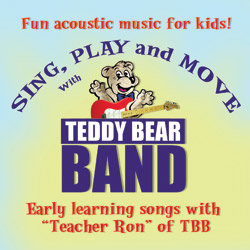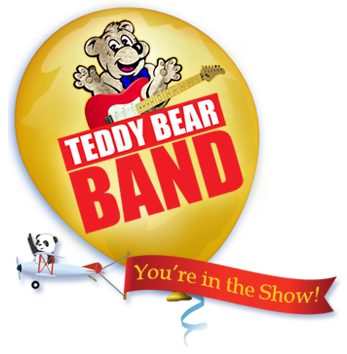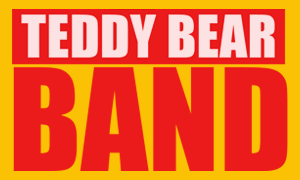The new album from Teddy Bear Band, featuring fun acoustic music for kids!
Language & Learning Opportunities through Music for Young Children
Song Info. & Activities: Annette Gagliardi, M.Ed. (See note*) and Ron Gustafson, B.A.
 Note to Parents: Hey Moms & Dads, YOU are your child’s first and most important teacher. We encourage you to do these songs and actions with your young child(ren). It will make a difference in their enjoyment and level of participation, plus it’s fun!
Note to Parents: Hey Moms & Dads, YOU are your child’s first and most important teacher. We encourage you to do these songs and actions with your young child(ren). It will make a difference in their enjoyment and level of participation, plus it’s fun!
Note to Teachers: Hey…you know all of the above applies to you too! Doing these songs and actions together with young children will help them to be successful with these songs, and with early learning in preschool. Many of these songs are short so when kids have fun with one, repeat it! Repetition is the “gold standard” in early learning.
Note to Everyone: Songs on this album support “Emergent Literacy” for young children. They help young children understand aspects of language and experience how words have meaning. These songs also support “Cultural Literacy.” There are many reasons why the classic/old children’s songs get passed along to new generations. We believe musical and cultural diversity contributes to the vitality and quality of life. When parents and teachers share these songs with children, it creates and strengthens engagement with their own cultural heritage. The active ingredient for building young brains is a childs positive relationship with their parents and other caregivers. Singing, learning and moving along with these songs helps to establish us all as Americans. Now let’s have fun with music!
1. Hello Everybody #1 (R. Gustafson)
A greeting song that encourages clapping and kicking! Singing is a great way to have fun with language!
2. Hickory Dickory Dock (trad.-Arr. Gustafson/Erickson)
Here’s a strong beat that provides children opportunities to learn rhythm through music and language. Encourage kids to stand with their arms out on either side and rock back and forth for a pendulum beat.
3. Head, Shoulders, Knees & Toes (“Mock Opera”) (trad.-Arr. R. Erickson)
First there is vocabulary of body parts, then a word to object correspondence in touching the part you’re naming.
 Ask children to sing the song in a funny way and see what they come up with. Now ask them to do this with other body parts like elbows, belly button, hair, neck, etc.
Ask children to sing the song in a funny way and see what they come up with. Now ask them to do this with other body parts like elbows, belly button, hair, neck, etc.
4. Head Shoulders Knees, Toes & More! (Bluegrass) (trad.-Arr. R. Erickson)
This song changes the beat/rhythm of a song most children already know. This provides opportunity for comprehension and Rapid Automatic Naming (RAN) which builds fluency in language. Background knowledge and vocabulary are added as extra body parts are named. This silly song encourages children to participate!
 Talk about and help your child learn the names for their body parts. Notice the rhyming words and help your child talk about other words that rhyme.
Talk about and help your child learn the names for their body parts. Notice the rhyming words and help your child talk about other words that rhyme.
5. If You’re Happy & You Know It – Introduction (Gustafson/Erickson)
Children love to shout the words out as they sing this song. It is a challenge to do all the motions and sing along with the music. This song offers background knowledge and vocabulary about emotions. Research has proven how important it is to have conversations with young children. When you add motions to the words you are singing, it provides children with a concrete concept of the word.

Talk with your child to provide the give and take of conversations. Sing and dance along with your child.
6. If You’re Happy & You Know It (trad.-Arr. Gustafson/Erickson)
This song provides children with a well-rounded approach to learning words and supports their language learning.
 Talk with your children about their emotions. When they are happy, sad, or mad, what actions can they take? How do they express emotions? Tell them how you express your emotions.
Talk with your children about their emotions. When they are happy, sad, or mad, what actions can they take? How do they express emotions? Tell them how you express your emotions.
7. The Hip, The Hip, The Hippopotamus (trad.-Arr. Gustafson)
Here is a wonderful song with an emphasis on beginning letter sounds. It provides lots of opportunity to play with and learn letter sounds. (phonemic awareness) Young children focus on learning the beginning sounds of words first and this song provides lots of that. The story line is fun and funny. Children enjoy thinking about different animals getting onto a bus and following the story of who comes on the bus.
 Take a city bus or school bus with your child. Look to see if any animals come on the bus. Visit the zoo or a farm to see what animals look and sound like.
Take a city bus or school bus with your child. Look to see if any animals come on the bus. Visit the zoo or a farm to see what animals look and sound like.
8. Jump Around! (Gustafson/Erickson)
This song is about movement and alphabet knowledge. Sing the letters of each word while doing the actions; J-U-M-P encourages jumping. The physical activity helps children remember the words-AND how to spell them. In doing this song, children get the idea that words are made up of individual letters. The words in this song may be some of the first words these children will be able to read.
 Use magnetic Alphabet letters on your refrigerator to create words and allow your child to create words using letters. Your child might want to repeat this song again and again.
Use magnetic Alphabet letters on your refrigerator to create words and allow your child to create words using letters. Your child might want to repeat this song again and again.
9. Wheels On The Bus (trad.-Arr. Gustafson)
Here’s opportunity for active participation and creating background knowledge about buses. (Buses have wheels, a door, windows, wipers, a horn, people ride in them, etc.) When you do actions with the words as you sing, you add the kinesthetic piece which provides children with a physical connection to their words. This helps them cement the concept into their brains.
 Take a ride on a bus and look at parts of a bus. Beep the horn and turn on the windshield wipers of your car to show your child how these things work.
Take a ride on a bus and look at parts of a bus. Beep the horn and turn on the windshield wipers of your car to show your child how these things work.
10. Bringing Home A Baby Bumble Bee & Baby Dinosaur!
What a funny song! Children love this because they are laughing and having fun thinking about the bumble bee and dinosaur. The song also provides rhyming and a sequence of events with a beginning, middle and end to this short story. Notice the change in the singers’ voice as they pick up the dinosaur and how it grows. Children love to imitate those actions (stretching arms wide as the dinosaur grows).
 Read books or tell stories that have a clear beginning, middle and end. Talk with your child about what happened first, second, next and last. Help your child learn what a real bee looks like.
Read books or tell stories that have a clear beginning, middle and end. Talk with your child about what happened first, second, next and last. Help your child learn what a real bee looks like.
11. The Alphabet Song (trad.-Arr. R. Erickson)
We communicate with a symbol system and that system is the alphabet. Singing the alphabet song helps children familiarize themselves with the symbol system that makes up our language.
 Sing this song at home without the recording to help remember it. Sing the song as you march around the room to add a kinesthetic (movement) component that helps cement the song into your child’s brain.
Sing this song at home without the recording to help remember it. Sing the song as you march around the room to add a kinesthetic (movement) component that helps cement the song into your child’s brain.
12. The Drawkcab Tebahpla Song (The “Backward Alphabet” Song) (trad.-Arr. R. Erickson)
This song is fun for adults as well as children. It is more of a challenge for adults than children because adults have the regular Alphabet song memorized. Try singing this song while marching or walking backward. It adds another dimension and provides coordination skills practice. Walking and singing backwards is difficult and stretches the brain to think in an unusual way.

Display the alphabet on a chart, or use magnetic letters on your refrigerator. Help kids point to the letters as they are sung.
13. Land & Sea (trad.-Arr. Gustafson/Erickson)
Kids pretend they’re flying during this song and follow directions to clap, kick and turn in a circle. When adults model these actions, they support comprehension and definitions of vocabulary that children are beginning to understand.

When you do these actions with your children, you provide a wonderful role model and provide the idea that this is important.
14. Open Shut Them, Introduction (trad.-Arr. R. Gustafson)
When children sing along, they practice vocabulary. As adults model the actions of the words, children gain the meaning of new vocabulary. When children see what you are doing, they learn very quickly what to do and the name for what they are doing.
15. Open Shut Them, Slow (trad.-Arr. R. Erickson)
When adults talk intentionally slower or faster, higher or lower, quiet or louder, they help children learn the variety of sounds and contrasts that voices can produce.

Sing this song with your child in a high and low voice, in a quiet and loud and in a fast and slow voice. Have fun.
16. Open Shut Them, Fast (trad.-Arr. R. Erickson)
These songs demonstrate opposites. Help your child notice and talk about opposites of other things (up/down, sweet/sour, over/under, etc.)
17. Old McDonald (trad.-Arr. R. Gustafson)
Ron sings this familiar melody with “la la la’s” before he sings the words. This exercise helps children practice thinking skills and develop their auditory discrimination. This traditional song is part of American cultural literacy: it’s a song most adults know. Children learn background information about which animals live on a farm, animal names and sounds.
 Parents can help children learn the names of animals on the farm and the sounds each animal makes. Play a guessing game where you hum or play just the melody of a favorite song and ask your child to name it.
Parents can help children learn the names of animals on the farm and the sounds each animal makes. Play a guessing game where you hum or play just the melody of a favorite song and ask your child to name it.
18. Five Little Puppies (R. Gustafson)
Ron uses humor and “nonsense” to encourage children’s critical thinking skills. When an adult does something different from the usual, children will notice and pay attention. Parents and teachers can do this with other songs and stories that children know well.
19. Five Little Monkeys (trad.-Arr. Gustafson/Erickson)
This song is another counting song, backward from five to one. Anytime you have five of something, you can use your one hand to count. Our hands are so useful for counting and this song helps children learn to count providing one-to-one correspondence. Monkeys jumping on the bed is a favorite for children because it is just so much fun to jump.

Ask your children to be the monkey and jump, pretend to fall and act out the actions in this song.
20. Teddy Bear Turn Around (trad.-Arr. Gustafson/Erickson)
The slow, mellow singing and rhythm of this song helps children calm down. Singing about the actions children are doing provides concrete connection to the words for understanding. This song provides a beginning, middle and end of getting ready for and going to bed. Sleep tight.
 Parents can add conversation to this song by talking and asking about what steps your child goes through on their way to bed (read a book, brush teeth, etc.) Ask your child to “snore” and pretend to sleep as a fun role-play.
Parents can add conversation to this song by talking and asking about what steps your child goes through on their way to bed (read a book, brush teeth, etc.) Ask your child to “snore” and pretend to sleep as a fun role-play.
21. Goodbye Everybody (trad.-Arr. Gustafson/Erickson)
This song provides a cultural experience of waving good-bye and provides a sense of closure. Saying good-bye in some way signals for children that this music and play will end, and a new event will begin.

Talk about how other cultures say good-bye – for instance Chinese people bow.
• Annette’s Children’s book: Many of you have read The Three Billy Goats Gruff, but have you heard of their dancing cousins, The Three Betty Goats Griff? Annette’s book provides a wonderful new take on this old favorite. The website offers activity pages, teacher and parent ideas and the book in a variety of languages.
Visit: www.threeBettyGoatsGriff.com

